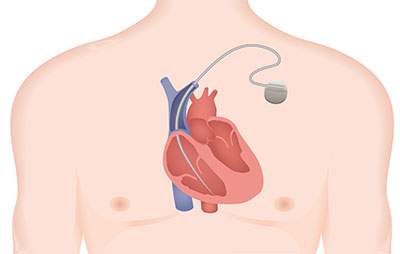Implantable Cardioverter Defibrillator

An Implantable Cardioverter Defibrillator (ICD) is a small, battery powered, pager size device.
It is used in patients at risk for:
- Ventricular tachycardia (when the lower chambers of the heart independently beat faster than 100 beats per minute)
- Ventricular fibrillation (when the muscle fibers of the lower chambers of the heart contract in a fast, uncoordinated manner)
- Sudden cardiac death caused by arrhythmias
Once the ICD is implanted, the leads monitor the heart rate. If the ICD detects ventricular tachycardia or fibrillation, it sends out a controlled burst of impulses (called "overdrive" pacing). If this does not work, the ICD "shocks" the heart
to restore a normal rhythm. ICDs are very effective in preventing sudden deaths and can be implanted with a low rate of complications.
A defibrillator is made up of two parts:
- A pulse generator, which includes the battery and several electronic circuits
- Wires, called leads that are attached to the heart wall. Depending on the type of ICD, you may have one to three leads.
The defibrillator is implanted beneath the skin, near the collarbone. The leads are placed inside the heart or on its surface and are attached to the defibrillator.
Once the ICD is implanted, the leads monitor the heart rate. If the ICD detects ventricular
tachycardia or fibrillation, it sends out a controlled burst of impulses (called "overdrive" pacing). If this does not work, the ICD "shocks" the heart to restore a normal rhythm. ICDs are very effective in preventing sudden deaths and can be implanted
with a low rate of complications.
